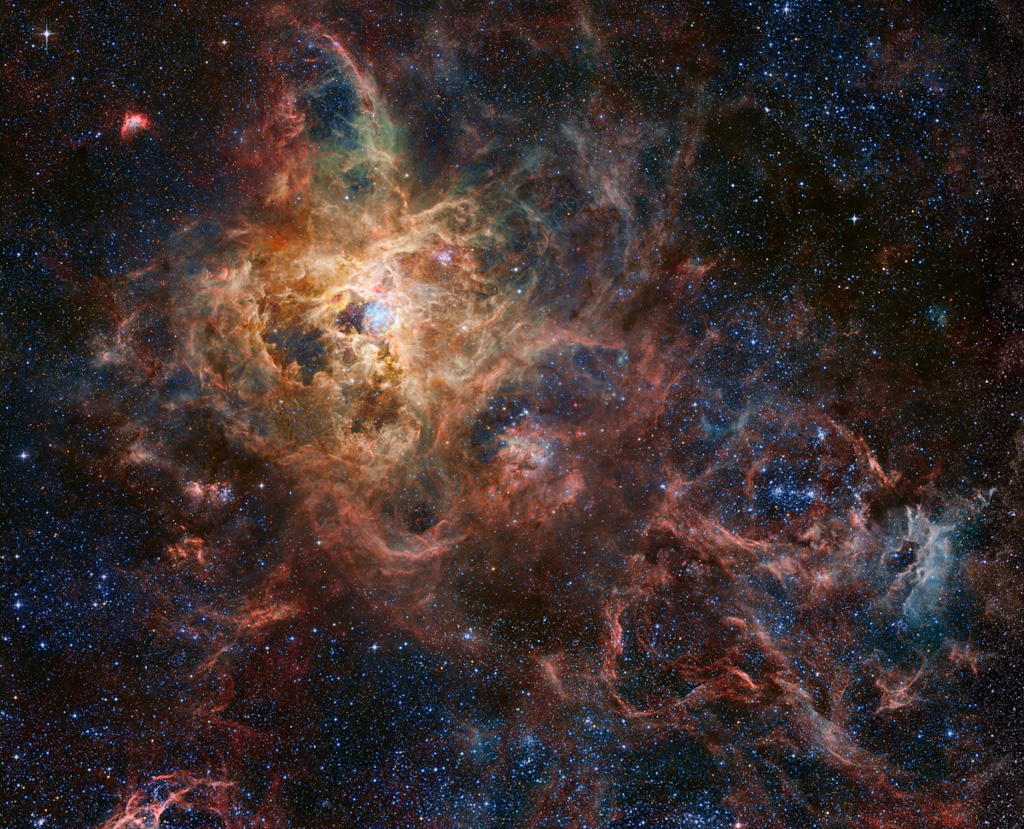蜘蛛區
The Tarantula Zone

來源:Robert Gendler|發表日期:2024-03-08
蜘蛛星雲,又名多拉多斯 30 ,直徑超過一千光年,是附近衛星星系大麥哲倫雲中一個巨大的恆星形成區。它距離我們大約 18 萬光年,是整個本星系群中已知的最大、最劇烈的恆星形成區域。這隻宇宙蜘蛛遍佈在這幅壯麗的圖景中,它是由大型太空望遠鏡和地面望遠鏡的影像資料組合而成的。在狼蛛(NGC 2070 )內部,強烈的輻射、恆星風和來自被編入 R 136 星團的年輕大質量恆星中央星團的超新星衝擊為星雲光輝提供了能量,並形成了蛛絲。在塔蘭圖拉周圍還有其他恆星形成區,其中有年輕的恆星群、絲狀物和吹出的氣泡狀雲。事實上,畫面右下方還包括現代最接近的超新星--SN 1987 A 的位置。豐富的視場跨度約為 2 度,即南天星座的 4 個滿月。但是,如果塔蘭圖拉星雲離銀河系更近一些,比如像銀河系自身恆星形成的獵戶座星雲那樣距離 1500 光年,那麼它將佔據半個天空。
原文:The Tarantula Nebula, also known as 30 Doradus, is more than a thousand light-years in diameter, a giant star forming region within nearby satellite galaxy the Large Magellanic Cloud. About 180 thousand light-years away, it's the largest, most violent star forming region known in the whole Local Group of galaxies. The cosmic arachnid sprawls across this magnificent view, an assembly of image data from large space- and ground-based telescopes. Within the Tarantula (NGC 2070), intense radiation, stellar winds, and supernova shocks from the central young cluster of massive stars cataloged as R136 energize the nebular glow and shape the spidery filaments. Around the Tarantula are other star forming regions with young star clusters, filaments, and blown-out bubble-shaped clouds. In fact, the frame includes the site of the closest supernova in modern times, SN 1987A, at lower right. The rich field of view spans about 2 degrees or 4 full moons in the southern constellation Dorado. But were the Tarantula Nebula closer, say 1,500 light-years distant like the Milky Way's own star forming Orion Nebula, it would take up half the sky.
※ 本文由萌芽機器人自動轉貼自每日一天文圖(Astronomy Picture of the Day,APOD),原文為英文,正體中文是透過 DeepL 翻譯及 OpenCC 進行自動處理,內容僅供參考,若有任何錯誤之處還請見諒!
關於每日一天文圖:每日一天文圖網站是美國國家航空暨太空總署與密西根理工大學提供的服務,網站每天提供一張影像或圖片,並由天文學家撰寫扼要說明其特別之處。